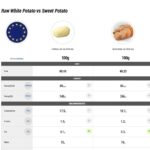If you’ve recently been diagnosed with type 2 diabetes, navigating dietary changes can feel overwhelming. It’s natural to be concerned about what you can and cannot eat. While it’s a myth that type 2 diabetes requires a restrictive “diabetes diet”, understanding which foods to limit or avoid is crucial for managing your blood sugar levels and overall health. As a food expert at foods.edu.vn, I’m here to guide you through the key foods to be mindful of, empowering you to make informed choices and enjoy a balanced, healthy eating plan.
Understanding Type 2 Diabetes and Dietary Choices
Type 2 diabetes is a condition where your body doesn’t use insulin properly, leading to elevated blood sugar levels. Diet plays a pivotal role in managing this condition. Contrary to outdated advice that focused on strict restrictions, the modern approach emphasizes making healthier food choices more often. It’s about moderation and balance, not deprivation. By understanding the impact of different foods on your blood sugar, you can take control of your health and reduce the risk of diabetes-related complications such as heart disease, stroke, and certain cancers.
It’s important to move away from the idea of a rigid “diabetes diet” and instead focus on adopting sustainable, healthy eating habits. Personalized dietary needs vary, and what works for one person may not be ideal for another. The aim is to make realistic and achievable changes that you can stick to long-term. Setting personal goals, such as managing blood sugar levels, improving cholesterol, maintaining healthy blood pressure, achieving a healthy weight, or even aiming for diabetes remission, can provide motivation and direction. Remember, you’re not alone in this journey; millions are navigating type 2 diabetes and dietary adjustments.
Top Foods to Limit or Avoid with Type 2 Diabetes
While no foods are strictly “forbidden,” certain types can significantly impact your blood sugar levels and overall health. Focusing on limiting or avoiding these categories will be a major step in managing your type 2 diabetes effectively.
1. Sugary Drinks
Sugary drinks are perhaps the most critical category to avoid. These beverages, including sodas, fruit juices (even 100% juice), sweetened teas, energy drinks, and flavored waters, are packed with rapidly absorbed sugars that cause a sharp spike in blood glucose. They offer minimal nutritional value and contribute to weight gain, making blood sugar control more challenging. Even seemingly “natural” options like fruit juice, while containing vitamins, are concentrated sources of sugar and lack the fiber found in whole fruits that helps slow sugar absorption.
Instead of sugary drinks, opt for:
- Water: Hydration is key, and water is the perfect sugar-free choice.
- Unsweetened tea and coffee: Enjoy hot or iced versions without added sugar.
- Sparkling water: For a fizzy alternative, choose unsweetened sparkling water, and add a slice of lemon or lime for flavor.
- Infused water: Add slices of cucumber, berries, or herbs to water for a refreshing and flavorful, sugar-free drink.
2. Processed Foods
Highly processed foods are often loaded with unhealthy fats, sodium, and added sugars, all of which can negatively impact blood sugar control and overall health. These foods are typically low in fiber and nutrients, offering empty calories that contribute to weight gain and insulin resistance. Examples of processed foods to limit include:
- Packaged snacks: Chips, crackers, cookies, candy, and processed snack bars are often high in refined carbohydrates, unhealthy fats, and added sugars.
- Fast food: Fried foods, burgers, pizza, and many fast-food meals are high in calories, unhealthy fats, and sodium.
- Processed meats: Bacon, sausage, hot dogs, and deli meats are often high in saturated fat and sodium and have been linked to an increased risk of certain health conditions.
- Pre-packaged meals: Many frozen dinners and ready-to-eat meals can be high in sodium, unhealthy fats, and added sugars.
Focus on whole, unprocessed foods like:
- Fruits and vegetables: Naturally sweet and packed with fiber, vitamins, and minerals.
- Lean proteins: Chicken, fish, beans, lentils, and tofu are excellent sources of protein without added sugars or unhealthy fats.
- Whole grains: Brown rice, quinoa, oats, and whole-wheat bread provide fiber and sustained energy release.
- Nuts and seeds: Healthy fats, protein, and fiber in moderation.
3. Refined Carbohydrates
Refined carbohydrates, also known as simple carbs, are quickly digested and can cause rapid spikes in blood sugar levels. These carbs have been stripped of their fiber and nutrients during processing. Examples include:
- White bread: Made from refined white flour, it lacks fiber and nutrients.
- White pasta: Similar to white bread, it’s low in fiber and quickly raises blood sugar.
- White rice: While a staple in many diets, white rice is a refined carbohydrate.
- Sugary cereals: Many breakfast cereals are heavily processed and loaded with added sugars.
- Baked goods: Cakes, pastries, cookies, and muffins are often made with white flour and sugar.
Choose whole grain alternatives:
- Whole-wheat bread: Provides more fiber and nutrients than white bread.
- Whole-wheat pasta: A better option than white pasta due to its higher fiber content.
- Brown rice: Retains more nutrients and fiber compared to white rice.
- Oatmeal: A great breakfast choice, especially steel-cut or rolled oats, which are less processed.
- Quinoa: A complete protein and a good source of fiber.
4. Saturated and Trans Fats
Unhealthy fats, particularly saturated and trans fats, can contribute to insulin resistance, weight gain, and increased risk of heart disease, which is already a concern for people with type 2 diabetes. Foods high in unhealthy fats include:
- Fried foods: French fries, fried chicken, and other deep-fried items are typically high in trans fats and saturated fats.
- Fatty cuts of meat: Red meat, especially marbled cuts, and processed meats can be high in saturated fat.
- Full-fat dairy products: Whole milk, cheese, and butter contain saturated fat.
- Processed snacks: Many chips, crackers, and cookies contain unhealthy fats.
- Some vegetable oils: While some vegetable oils are healthy, others like palm kernel oil and coconut oil are high in saturated fat.
Choose healthier fat sources:
- Olive oil: A monounsaturated fat beneficial for heart health.
- Avocado: Rich in monounsaturated fats and fiber.
- Nuts and seeds: In moderation, provide healthy fats, protein, and fiber.
- Fatty fish: Salmon, tuna, and mackerel are rich in omega-3 fatty acids, which are beneficial for heart health.
5. Excessive Alcohol
While moderate alcohol consumption may be acceptable for some individuals with type 2 diabetes, excessive drinking can be problematic. Alcohol can interfere with blood sugar control, especially if you are taking certain diabetes medications. It can also be high in calories and contribute to weight gain. Furthermore, alcohol can sometimes mask the symptoms of hypoglycemia (low blood sugar).
If you choose to drink alcohol, do so in moderation and consider these tips:
- Check with your doctor: Discuss alcohol consumption with your healthcare provider, especially if you take insulin or other blood sugar-lowering medications.
- Drink with food: Consuming alcohol with a meal can help slow down sugar absorption.
- Choose sugar-free mixers: If mixing drinks, opt for diet sodas, sparkling water, or sugar-free tonic water.
- Monitor blood sugar: Check your blood sugar levels before and after drinking alcohol to understand its effects on you.
6. “Diabetic” Foods
Be wary of foods marketed specifically as “diabetic” or “suitable for diabetics.” These products are often not healthier than regular versions and can sometimes be more expensive. They may still raise blood sugar levels and can be misleading. Focus on reading nutrition labels and ingredient lists rather than relying on “diabetic” labels. Often, naturally sugar-free or lower-sugar options are readily available and more wholesome.
Alt text: A colorful bowl of whole grain cereal topped with fresh berries and milk, representing a healthy breakfast option for managing type 2 diabetes.
Making Sustainable Dietary Changes
The key to long-term success in managing type 2 diabetes through diet is to make gradual, sustainable changes. Instead of feeling restricted, focus on making positive swaps and adopting a balanced eating pattern.
- Focus on whole foods: Prioritize fruits, vegetables, lean proteins, and whole grains as the foundation of your diet.
- Practice portion control: Be mindful of serving sizes to manage calorie intake and blood sugar levels.
- Read nutrition labels: Become familiar with nutrition labels to make informed choices about packaged foods.
- Cook at home more often: Home cooking gives you greater control over ingredients and portion sizes.
- Plan your meals: Planning meals in advance can help you make healthier choices and avoid impulsive, less healthy options.
- Allow for occasional treats: It’s okay to enjoy treats in moderation. Focus on making healthier choices most of the time, and enjoy smaller portions of less healthy foods occasionally.
Seeking Support and Guidance
Remember, you don’t have to make these changes alone. Seeking support and guidance can significantly enhance your journey in managing type 2 diabetes through diet.
- Consult a registered dietitian: A dietitian specializing in diabetes can provide personalized meal plans and advice tailored to your specific needs and preferences.
- Talk to your healthcare team: Your doctor or diabetes educator can offer valuable guidance and support.
- Join a diabetes education program: Structured education courses can provide comprehensive information and practical skills for managing diabetes.
- Connect with online communities: Online forums and support groups can offer peer support, shared experiences, and valuable tips from others living with type 2 diabetes.
Conclusion
Managing type 2 diabetes involves making informed choices about the foods you eat. While certain foods are best limited or avoided, the focus should be on building a balanced, healthy eating plan that you can sustain long-term. By prioritizing whole foods, limiting sugary drinks and processed items, choosing whole grains over refined carbs, being mindful of unhealthy fats, and seeking support when needed, you can effectively manage your blood sugar levels, improve your overall health, and live a fulfilling life with type 2 diabetes. Remember, small, consistent changes make a big difference.

